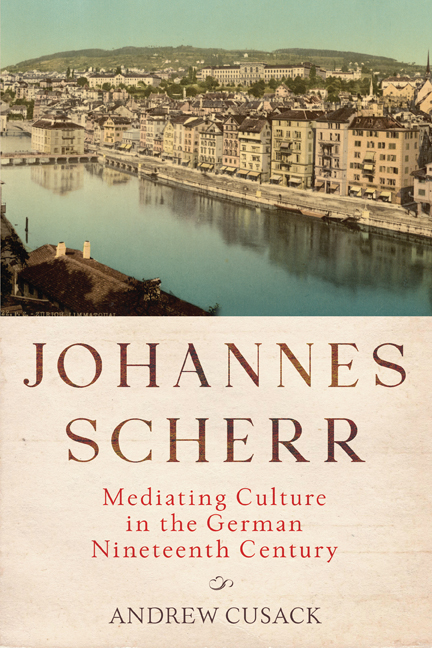Book contents
- Frontmatter
- Contents
- Acknowledgments
- Note on Translations and the Use of German Texts
- Introduction: The Success and Failure of Johannes Scherr
- 1 Scherr’s Liminality: Between Nations and Academic Cultures
- 2 The Cultural Historian as Mediator
- 3 Worlding German Literature
- 4 Weltschmerz and Pessimism—Scherr’s Old-Age Style
- Conclusion: Where Next for Scherr?
- Appendix: Overview of Essays in the Menschliche Tragikomödie
- Notes
- Bibliography
- Index
2 - The Cultural Historian as Mediator
Published online by Cambridge University Press: 23 March 2021
- Frontmatter
- Contents
- Acknowledgments
- Note on Translations and the Use of German Texts
- Introduction: The Success and Failure of Johannes Scherr
- 1 Scherr’s Liminality: Between Nations and Academic Cultures
- 2 The Cultural Historian as Mediator
- 3 Worlding German Literature
- 4 Weltschmerz and Pessimism—Scherr’s Old-Age Style
- Conclusion: Where Next for Scherr?
- Appendix: Overview of Essays in the Menschliche Tragikomödie
- Notes
- Bibliography
- Index
Summary
Die Stufe der Mittelbildung: Scherr's Readers and His Popular Style
SHORTLY AFTER TAKING his doctorate at the University of Tübingen, Johannes Scherr was back in the Canton of Zurich, teaching at Thomas Scherr's private school, the Sonnenberg in Winterthur. The brothers must often have discussed the Sixth of September 1839 and the events that cost Thomas his place in the cantonal government, forcing him to make a living by taking in paying students. How could a process of reform that had seemingly taken root in the hearts and minds of Zurichers have so easily been derailed by the bungled appointment of David Friedrich Strauß to the chair in New Testament theology at the University of Zurich? What could be learned from the defeat, and how could the recurrence of such a setback be prevented in future? Religion lay at the heart of the Sixth of September fiasco. In attempting to reform the religious life of the Canton of Zurich and bring it into line with liberal ideals, the liberal government had seriously overreached itself. The liberals had underestimated the strength of their fellow citizens’ attachment to the teachings and practices of the Reformed Church established by Huldrych Zwingli. Nevertheless, the religious fervor whipped up in 1839 was short-lived. By the time of Johannes Scherr's return to Winterthur in 1841, the prospects for a liberal return to power in the canton were good.
The time was ripe for a publication that would help revive the project of Volksbildung, the education of the people, by treating the subject of religion sensitively and setting it in the context of the history of ideas. This, in essence, was what David Friedrich Strauß had set out to do with the two volumes of Das Leben Jesu (1835; The Life of Jesus); but, as the Scherrs noted, Strauß's book had been aimed at scholars and not at the general public. Thomas and Johannes Scherr set out to compile a book that would explain the history of religious and philosophical thought in terms comprehensible to an educated lay reader.
The result of their efforts was the three-volume Gemeinfaßliche Geschichte der religiösen und philosophischen Ideen (1840–42; Generally Comprehensible History of Religious and Philosophical Ideas).
- Type
- Chapter
- Information
- Johannes ScherrMediating Culture in the German Nineteenth Century, pp. 49 - 81Publisher: Boydell & BrewerPrint publication year: 2021

